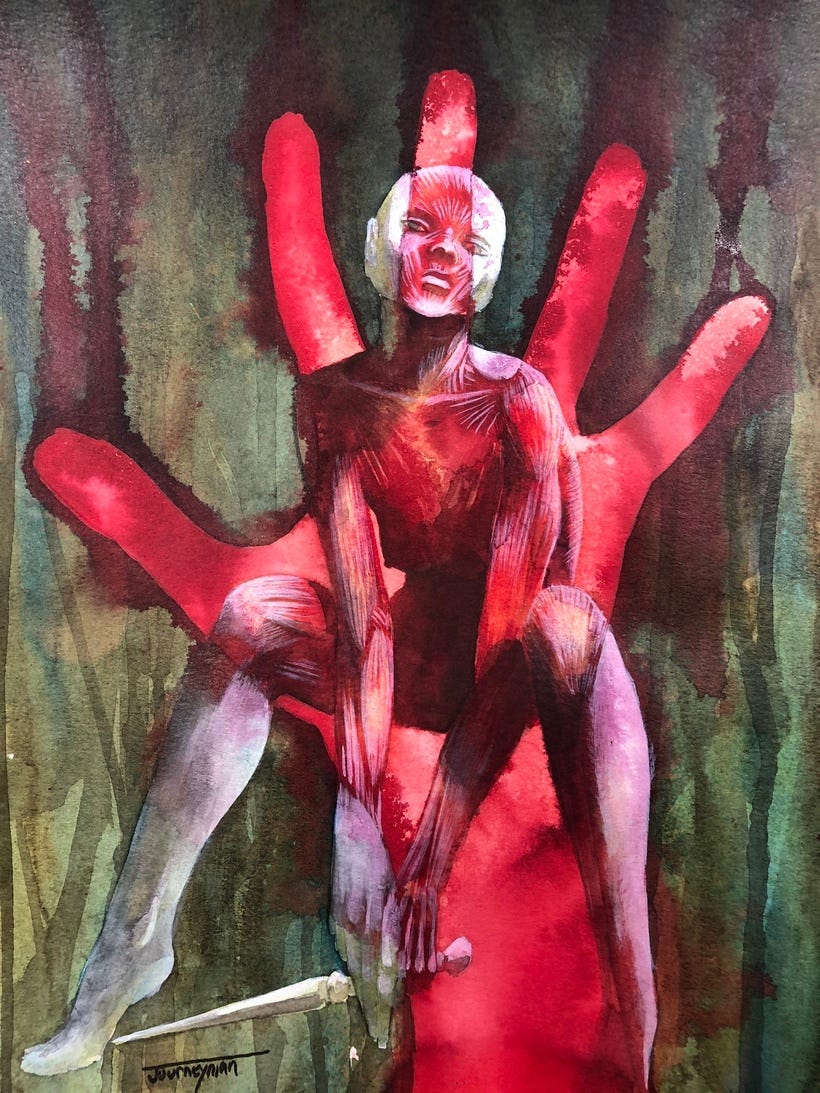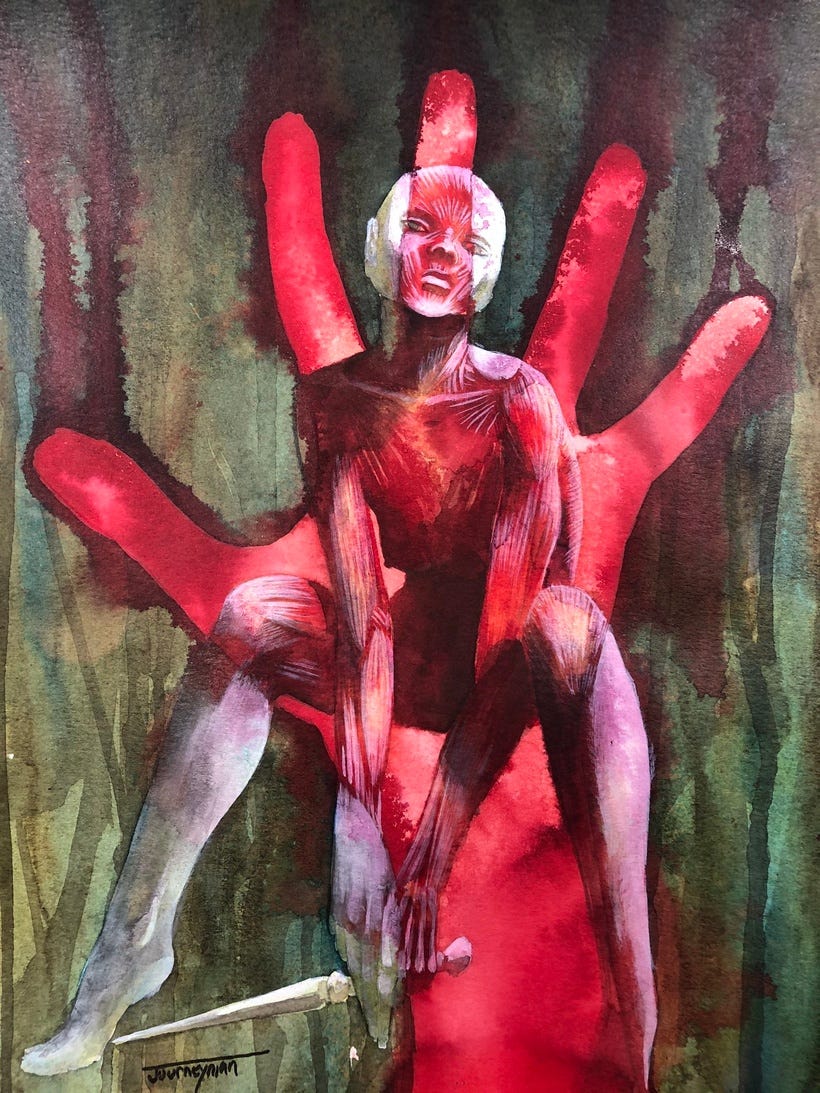Amazing! Warehouse, Part 4
Obstacles, Threats, and Villains
“Hand and Body” by Journeyman
A Reminder of the Setting
From an earlier post:
What could you have against the Amazing! Warehouse? That vast warehouse larger on the inside than even the already gargantuan exterior. It folds upon itself, finding impossible spaces, so that it can store anything and everything, and it connects seemingly everywhere, or almost everywhere, so it can deliver to you whatever you need within a day or two.
Sometimes it rains in the Amazing! Warehouse. Sometimes the wind whips through it. And there are canyons in the Amazing! Warehouse, and mountains of stacked boxes that block the artificial lights and create artificial valleys of shadow. And there are tunnels. Some are temporary, haphazard, created by the movement of shelves, for the shelves have thin, strong steel legs, like mechanized storks, like Baba Yaga’s Mecha-Hut and they move according to the needs of the warehouse. Those tunnels have collapsed like a magician’s trick, and workers in those tunnels are never seen again. Rumor has it that their bodies, quartered or worse, are shipped to unsuspecting customers. Others believe that they are simply lost, stranded forever in an unknown dimension.
The Amazing! Warehouse is a crossroads, a nigh-infinite dimension, the fossil of a dead universe, and it connects everywhere, like a mound of fungus under an ancient forest, like creeping vines through a decrepit mansion, and in this vast country, you must create your own little state.
Your portion of the Amazing! Warehouse must include the elements that the players create when they create their characters. For instance, my friend Travis just sent me a character, a monkey named Spike who has a magic tail. Spike’s territory is the rafters of the Amazing! Warehouse, and his loyal allies are Snakes.
When you get together as a group, you’ll have a bunch of little details like this, gifts that anyone can use to populate the warehouse, but particularly the GM. What makes the rafters special? What’s hidden in them? Who else uses the rafters? Who wants them? Why are the Snakes loyal to Spike? What kind of snakes are they? Is there a leader? Worry these little details, friend GM, until they become pearls.
In addition to the details gathered from players’ characters, the GM and the group must also consider what they want their season -- their game play -- to be like. I had written this earlier:
Some groups may want to play a game of blood, glory, and tragedy in which animals and workers together overthrow Oz and destroy the warehouse.
Others may want to play a game of mazes and treasure, in which a scouting party of animals raids the best parts of the warehouse, avoids traps, and perhaps fights guard dogs.
Still others may want to play a cozier game of little missions, alliances with kindly workers, helping those workers when they get in trouble, and so on.
Consider how each of those different seasons would necessitate different parts of the warehouse. The heroic (or anti-heroic!) overthrow of the warehouse would likely require that the boss’s office be a central location.
A season of mazes and treasures would require many locations each with their own dangers, mysteries, and rewards as well as a central location where the characters could restock their provisions and rest.
A cozier season of little missions would also have varied locations, but these would be known locations rather than mysterious ones, and they or their inhabitants would be under threat, but nothing too dire.
A season of political intrigue could have varied locations, each under the tenuous control of one group or another, all of them a little too close to each other, and in competition for vital resources such as food and water.
How to Deal with Obstacles, Threats, and Villains
A reminder about how to do things:
Declare what you want to do.
The GM determines the difficulty on a scale of 0 to 4.
Choose a relevant trait, add or subtract any modifiers for the environment, preparation or lack of it, tools, and so on.
Compare that value to the difficulty. If it matches or exceeds the difficulty, you have succeeded, if not, you have failed.
How does a GM keep a threat, obstacle, or villain from being stale or predictable using the above steps? It seems that if you don’t use dice, you won’t have suspense. GMs, this is where you have to think like a storyteller.
The first rule is to summarize the boring stuff and narrate the easy stuff.
The second rule is to seek situations that are difficult, scary, tricky, or all three.
The third rule is to break those interesting situations into smaller decisions. A player tells you that they want their character, a black racer snake named Ranger to sneak past an observant “dragon” (one of the dogs of the setting).
You ask the player how Ranger will sneak past the dragon.
The player asks you to further describe the environment and the situation.
Maybe you make up some details on the fly, maybe you have some of this prepared, and maybe you ask the players to make some of it up too.
And this is where the suspense comes in, without dice.
You emphasize the perceptions of the character: “You think that shadow between the boxes could provide you with additional cover.”
You mention potential problems with the plan: “Remember that animal is a dog and it has more senses than just sight.”
You or the players add to the environment and situation in a back and forth until you say something like: “I think we’ve exhausted this. What is your first step?”
Then when the PC takes that first step, you go back to the directions at the top of this section, the comparison of trait +/- modifiers versus a difficulty number.
But let’s talk about what “failure” and “success” mean in this context. Since you’ve broken down a task into smaller steps, failure or success in one step does not necessarily mean that the entire venture succeeded or failed. Instead, success and failure become modifiers to the next step.
Obstacles and Threats
These will be particular to your setting, but always imagine a warehouse. There are many obstacles and threats in an actual warehouse or other institutional setting. This is an impossibly huge warehouse that, if you want, could have its own weather system. In addition, the overall setting is our modern world mashed (emulsified?) with chaos. You can add strange things happening to reality such as portals, time shifts, gravity problems, and so on. You can add truly chaotic beings or monsters to the mix.
Villains and Monsters
You can create your own villains and monsters based on your setting and your players’ characters. Other animals may certainly be villains and monsters. The following are just some that are readily available.
I haven’t provided traits or stats for any of these because those are easy enough to assign but dependent on your setting as well. (Also, I’m getting tired, and I’ll handle it in more detail in the next revision).
You can certainly provide stats and traits for your antagonists. A rule of thumb is that the more attention an antagonist receives from the player, the more stats and traits the GM should give that antagonist.
(Remixed and revised from an earlier post)
The Dragons — Dogs that exude a miasmic breath and love to hunt the animals that live in the warehouse. Rumor has it that they are also turned loose on “traitorous” workers.
The Spiders — Silent, scuttling spies made of dead hands and eyes. Rumor has it that they are harvested from workers. First you hear the scuttling of the Spiders, then you feel the breath of the Dragons.
Golems -- R. Kam Smith created and designed these “robots” based on chaotic principles. They look unwieldy and malproportioned, but they are powerful, versatile, machines. The warehouse uses them for difficult actions such as retrieving large items from shelves that are high up. The warehouse could use actual machines for this, but something about using the golems amuses Smith.
An unwilling “governor spirit” provides the animating force for the golem. The governor spirits are angry and rebellious and only kept in line by Smith’s magical code. Still, the golems rebel in small ways and occasionally break free of Smith’s magic and then they become rampaging monsters.
Oz, the Overseer, the Winged Monkey — Oz, the Overseer of the Amazing! Warehouse, is a literal winged monkey. He never speaks, but he projects himself into the workers’ heads with terrible, corporate, motivational memes. He hunts the animals in the warehouse for sport.
NEXT POST: The first part of the revision, in which I take Amazing! Warehouse Parts 1-4 and organize into something coherent while cutting out fluff and adding more stuff.
Why is the art duplicated here? Because I can’t figure out how to delete the duplicate, so please enjoy Journey’s work again :)



